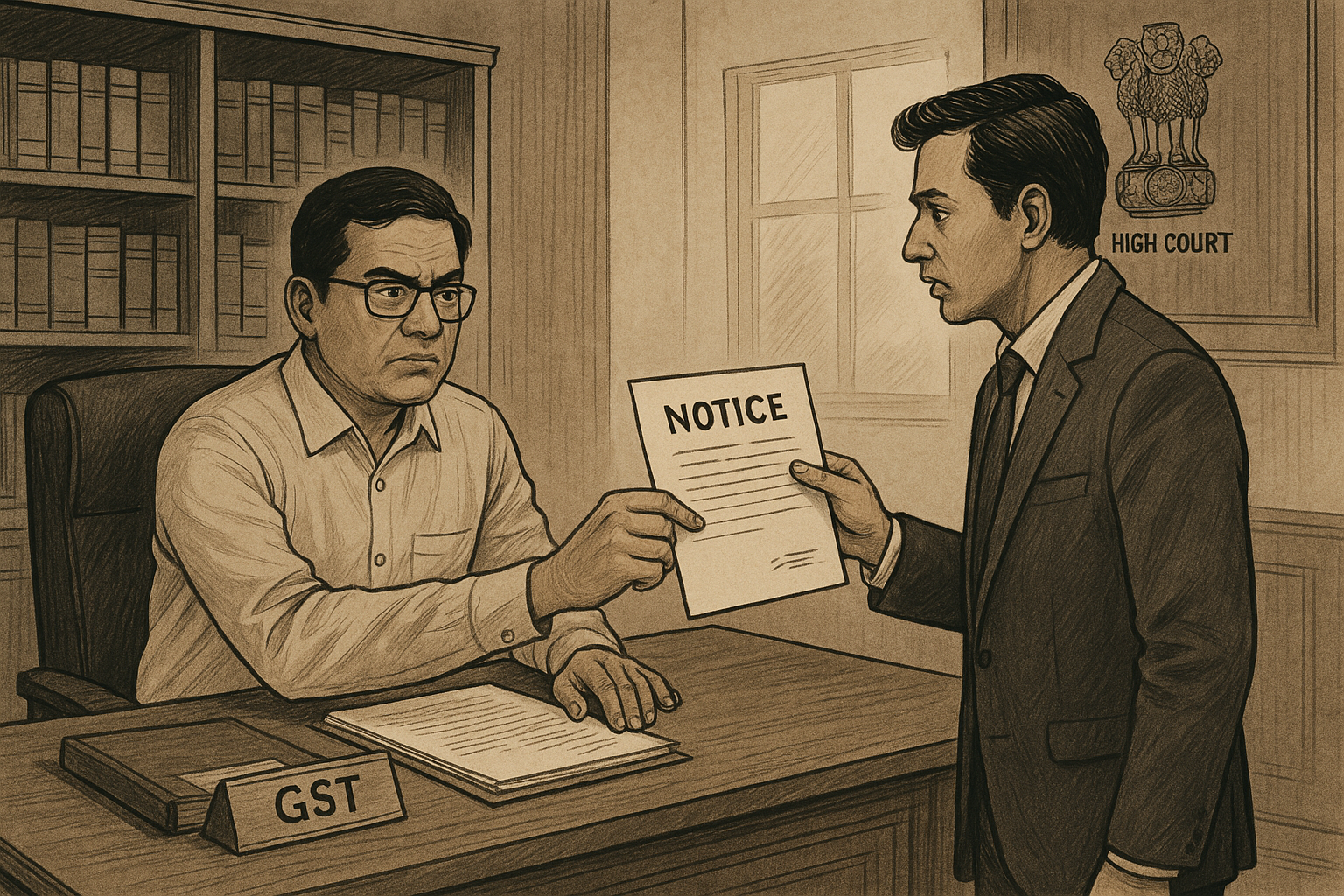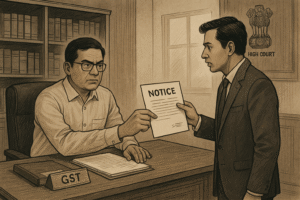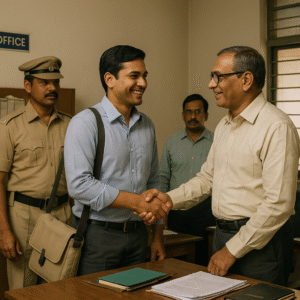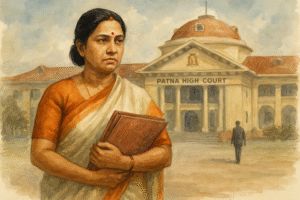The Patna High Court in 2024 refused to interfere with a demand-cum-show cause notice issued under Section 74(1) of the Central/Bihar Goods and Services Tax Act, 2017, after finding that the tax authorities had followed the statutory procedure of scrutiny under Section 61 read with Rule 99 of the Bihar GST Rules, 2017. The Court clarified that when a proper officer has already put the registered person on notice about a discrepancy in returns and the assessee has even responded to such notice, it is not open to the assessee to rush to the High Court and challenge the subsequent show-cause notice on the ground of “illegality” in initiation of proceedings.
In this case, the petitioner (a registered taxable person engaged in supply of goods) challenged the show-cause notice mainly on the ground that the department could not have straightaway invoked Section 74 without first issuing a proper scrutiny notice under Section 61 in the prescribed Form GST ASMT-10. The Court, however, on examining the records annexed with the writ petition, found that such a communication had in fact been issued to the petitioner in March 2022 pointing out the discrepancy in Input Tax Credit (ITC) as reflected in GSTR-9C and annual return, and the petitioner had also replied to it. Hence, the argument of “no opportunity” or “non-compliance of Section 61” was rejected.
The Bench comprising Hon’ble the Chief Justice and Hon’ble Mr. Justice Partha Sarthy held that writ jurisdiction under Article 226 is not meant to short-circuit the statutory mechanism whenever a show-cause notice is issued, especially in tax matters. Since the petitioner still had an opportunity to appear before the GST authority and contest the demand, the Court declined to entertain the writ petition and dismissed it, while clarifying that the petitioner would be free to raise all permissible objections before the adjudicating authority.
Simplified Explanation of the Judgment
This judgment is important for businesses, large taxpayers, and GST practitioners because it deals with a very common situation under GST: the department detects a mismatch or discrepancy in the returns, issues a communication, and then proceeds to issue a demand-cum-show cause notice under Section 73 or 74. Many assessees try to challenge such notices directly before the High Court on the ground that the procedure was not strictly followed. The Patna High Court has now said, in clear terms, that where the department has in fact issued a scrutiny communication and the assessee has replied, the challenge to the final show-cause notice will not be entertained.
What actually happened?
- The tax department scrutinised the petitioner’s return under Section 61 of the GST Act. Section 61 empowers the proper officer to scrutinise returns and, if any discrepancy is noticed, to inform the registered person and seek his explanation. Rule 99 of the Bihar GST Rules says that such communication should normally be in Form GST ASMT-10.
- A communication dated 30.03.2022 (noted in the annexures) was issued to the petitioner pointing out a discrepancy between the ITC declared in the annual return and the figures in the financial statement, particularly in Table 14T of Form GSTR-9C. The show-cause notice later referred to this communication, though there was a minor date error (31.03.2023 was mentioned instead of 31.03.2022). The Court treated this as a clerical mistake and not a ground to invalidate the proceedings.
- The petitioner did reply to the department. The petitioner said that uploading Form GSTR-9C was optional and that the unreconciled ITC in Column T was auto-populated, so it should not be held against the petitioner. The Court, however, made an important observation — if a taxpayer notices that the system has auto-populated a figure showing unreconciled ITC, then it becomes the taxpayer’s duty to explain the difference instead of simply taking the plea that the particular table was optional. In other words, the Court put the responsibility back on the registered person to clarify discrepancies that appear in statutory forms.
- After finding the petitioner’s explanation unsatisfactory, the department proceeded to issue a demand-cum-show cause notice under Section 74(1). Section 74 deals with cases where there is alleged fraud, wilful misstatement, or suppression of facts leading to short payment of tax. The petitioner attempted to challenge this notice before the High Court, arguing that since the prerequisite procedure under Section 61 was not followed properly, the notice itself was illegal.
- The Court examined the annexures itself — particularly Annexure-1 (the show-cause notice) and Annexure-3 (the earlier scrutiny communication) — and found that the communication, though not expressly titled as “Form ASMT-10”, was in substance the same as the model form given in the Rules. The Court adopted a substance-over-form approach. It said, in effect: “Just because the communication was not headlined as ASMT-10, it does not mean no scrutiny was done. The language is identical to the model Form and the assessee has also responded. Therefore, Section 61 stands complied with.”
- Because of this finding, the entire foundation of the writ petition collapsed. Once it was shown that the assessee had already been heard at the scrutiny stage, the Court held that the subsequent show-cause notice is only a “preliminary step” and not a final assessment. The petitioner still has a right to appear before the authority, file reply, produce documents, and argue. Hence, the Court said it “finds absolutely no reason to entertain the writ petition” and dismissed it. However, the Court protected the petitioner by allowing it to appear and raise all objections in the statutory proceedings if they were still pending.
In simpler words: the Court said — you have already been told about the discrepancy, you have already replied, and the officer has now issued a show-cause notice. At this stage, the High Court will not stop the officer from proceeding. Go back to the officer, take all your documents, and contest it there. The High Court will not act as a first-level assessing authority in GST.
Significance or Implication of the Judgment
- This judgment reinforces the limited scope of writ jurisdiction in GST show-cause matters. Businesses cannot bypass the adjudicating authority merely because they disagree with the scrutiny or believe that the form used was not in the exact statutory format.
- It tells GST officers that even if there is a minor defect in the heading or format of the scrutiny notice, the proceedings will not be vitiated if the substance of Section 61 and Rule 99 is followed and the taxpayer has been heard.
- For taxpayers, the message is clear: the moment a discrepancy is pointed out — even through a communication that looks informal — they should file a detailed, reasoned explanation with documents. A casual or technical reply (like “this column was optional”) may later be treated as unsatisfactory.
- The judgment also shows that auto-populated figures in GSTR-9C cannot be ignored. If the portal reflects an unreconciled ITC figure, the onus shifts to the registered person to reconcile and explain it.
- Finally, it underlines that the proper stage to argue on merits, limitation, classification, fraud vs. non-fraud, or even wrong invocation of Section 74 instead of Section 73, is before the adjudicating authority in response to the show-cause notice — not straightaway before the High Court.
Legal Issue(s) Decided and the Court’s Decision with Reasoning
- Whether a writ petition is maintainable against a GST demand-cum-show cause notice issued under Section 74(1).
- Decision: Not ordinarily maintainable when the assessee has an effective alternative remedy before the GST authority. The Court will not interfere at the show-cause stage.
- Whether non-issuance of Form GST ASMT-10 in the exact format invalidates subsequent proceedings under Section 74.
- Decision: No. If a communication substantially similar to ASMT-10 is issued, pointing out discrepancy and calling for explanation, and the assessee has responded, then the requirement under Section 61 read with Rule 99 stands satisfied. Substance is more important than format.
- Whether the assessee’s reply that GSTR-9C table was “optional” is sufficient to close scrutiny.
- Decision: No. If the portal has auto-populated an unreconciled ITC figure, it was incumbent on the assessee to explain it with proper reconciliation instead of taking a purely technical plea.
- Whether the Court can examine factual disputes (like reconciliation of ITC) in writ jurisdiction.
- Decision: No. Such disputes are to be adjudicated by the proper officer in statutory proceedings. The High Court will not decide factual reconciliation in a writ against show-cause notice.
Case Title
- M/s PepsiCo India Holdings Private Limited Vs. Union of India
Case Number
- Civil Writ Jurisdiction Case No. 5240 of 2024
Coram and Names of Judges
- Hon’ble the Chief Justice
- Hon’ble Mr. Justice Partha Sarthy
Names of Advocates and who they appeared for
- For the petitioner: Mr. Rohan Shah, Advocate; Mr. Ravi Bharuka, Advocate; Mr. Joybrata Misra, Advocate; Mr. Sanjeev Kumar, Advocate; Mr. Manish Mishra, Advocate; Mr. Shareen Gupta, Advocate; Mr. Tanay Vyas, Advocate. (All for the petitioner.)
- For the respondents (Union of India / CGST & CX authorities): Dr. K.N. Singh, ASG; Mr. Anshuman Singh, Sr. SC CGST & CX; Mr. Devansh Shankar Singh, Advocate. (For respondents.)
Link to Judgment
MTUjNTI0MCMyMDI0IzEjTg==-cMtkgRfG9cY=
If you found this explanation helpful and wish to stay informed about how legal developments may affect your rights in Bihar, you may consider following Samvida Law Associates for more updates.








